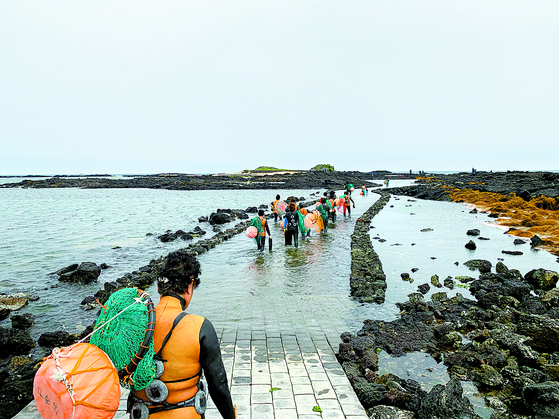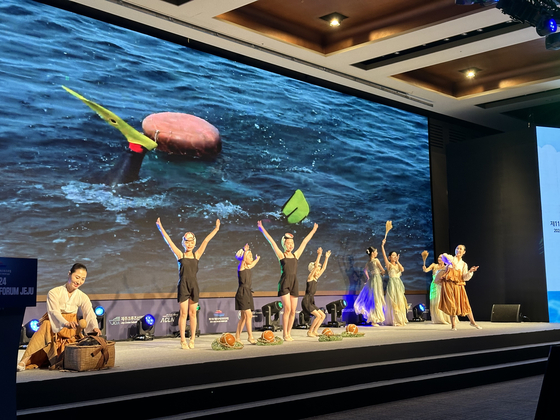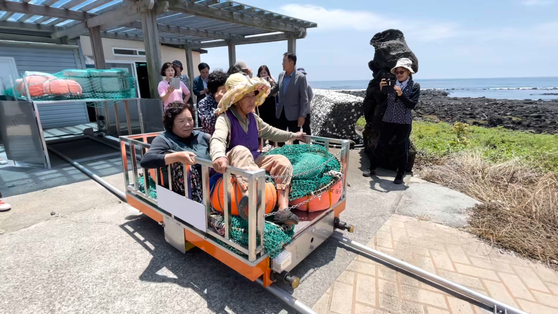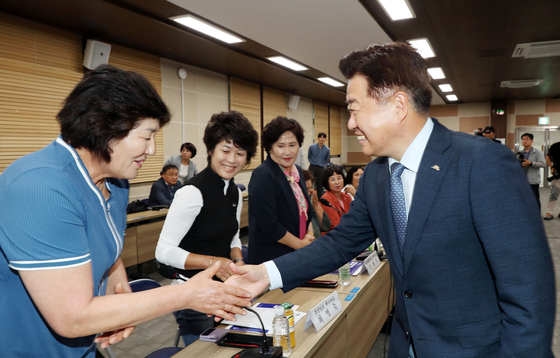As legendary female divers gradually disappear, the Jeju government is taking action

Haenyeos walk along the path in Hado-ri, Gujwa-eup, Jeju City, Jeju Island, preparing for their dive in February. (JOONGANG ILBO)
Jeju Island is taking significant steps to reverse the decline in the number of hannio.
Haenyeo, the female divers, dive without an oxygen mask to collect seaweed, shellfish and other seafood. The divers harvest for up to seven hours a day, diving for minutes at a time to depths of up to 10 meters.
While Haenyeo can be found in many coastal regions of Korea, the Haenyeo of Jeju are particularly known as a cultural landmark of the holiday island.
However, the number of new haenyeo on Jeju Island has been steadily declining. According to a statement from Jeju Island on Saturday, the numbers dropped from 50 in 2019 to 30 in 2020, 40 in 2021, 28 in 2022 and just 23 last year.

Artists perform during a haenyeo show at the 11th Jeju International Cruise Forum at Maison Glad Jeju in Yeongdong, Jeju on July 10. (JEJU TOURISM ORGANIZATION)
The main reasons for this decline are lower incomes and an ageing population.
Haenyeo earned an average of only 6.83 million won (US$4,940) per year in 2023.
“In the 1970s, haenyeo were able to acquire considerable wealth by using their income to buy houses and land, but this reality has changed drastically,” said a Jeju Island official.
The complicated process of becoming a haenyeo is another obstacle.
To become an official haenyeo, one must join a fishing village association, reside in the fishing village for two years to qualify as a fishing member, and be recognized by a general assembly of the fishing village. Association that charges a membership fee of two million won.
The aging of Jeju’s haenyeo population is also a cause for concern. Last year, 90.3 percent, or 2,565 of the 2,839 haenyeo, were over 60 years old. Only 99 were under 50 – six under 30, 27 in their 30s and 66 in their 40s.
To rejuvenate the Haenyeo population, Jeju Island is introducing extensive initiatives. The maximum age for joining a The fishing village association is raised from 40 to 45 years, and new Haenyeo aged 40 to 44 will receive a severance payment Fund of 500,000 won per month for three years. In addition, all new members will receive one million won to cover half of the fishing village association’s membership fee.
The draft law on these measures will be submitted to the Special Council of the Self-Governing Province of Jeju this month.

Haenyeos conducts a test run of a carrying device near Ilgwa-ri, Daejeong-eup, Seogwipo City, Jeju Island on June 13. (JOONGANG ILBO)
In some areas, baby carriers have already been installed to assist elderly haenyeo, such as in Ilgwa-ri, Daejeong-eup, in Seogwipo City.
With an installation cost of about 45 million won, the device can transport up to 500 kilograms of seafood and move it up to 130 meters on a remote-controlled rail.
In this way, six to seven divers can transport all the seafood they harvest daily at once.
“A single haenyeo usually has to carry about 200 kilograms of seafood collected in a week, which is impossible for older hanyeo,” said Park Hye-soon, chairman of the Ilgwa 2-ri fishing village association.

Jeju Governor Oh Young-hoon holds hands with haenyeo representatives during a meeting to establish a national haenyeo association at the Jeju Provincial Self-Government Special Office on June 26. (JEJU PROVINCE SELF-GOVERNMENT SPECIAL OFFICE)
In addition, a national haenyeo association will be established to protect the rights and interests of ten thousand female divers. On June 26, six coastal cities and provinces – Jeju, Gangwon, Ulsan, North Gyeongsang, Busan and South Gyeongsang – established a preparatory committee at the Jeju Self-Governing Provincial Government building.
After the election of preparatory members from South Jeolla and South Chungcheong, a non-profit organization under the Ministry of Maritime Affairs and Fisheries is to be established in October.
After being declared Korea’s No. 1 most important fishing heritage in 2015, Jeju Haenyeo was listed as a UNESCO Intangible Cultural Heritage in 2016, a National Intangible Cultural Property in 2017, and the World’s Most Important Agricultural Heritage Systems in 2023.
BY CHOI CHOONG-IL, WOO JI-WON ([email protected])



